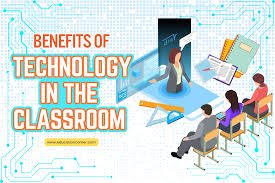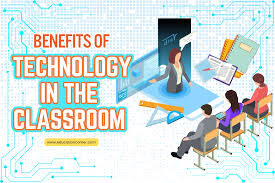
INTRODUCTION: Today’s classrooms are integrating technology more with each passing school year. Technology tools are physical or digital instruments designed to expand students’ capabilities, perform tasks, often facilitating learning, communication, or organization. Examples include hardware like computers and tablets, software like learning management systems and word processors. These tools are used across many fields, particularly in education, to enhance instruction, engage learners, and streamline processes. (Best Ed Tech Tools, 2005)
Types of educational technology tools used by many classrooms include: Interactive Whiteboards or Touch Screens: These allow for dynamic and engaging lessons. Learning Management Systems (LMS): Teachers are able to use platforms like Canvas and Google Classroom for organizing lessons and uploading assignments. Educational Apps: Teachers have access to complete lessons with resources, quizzes and assessments. Virtual Reality (VR): Students are able to have exposure to environments, which may be prohibited otherwise, to enhance their learning experiences. (Best Ed Tech Tools, 2005)
Tools such as computers and tablets are used for accessing the information uploaded in the LMS and to communicate with the teacher and fellow students. Applications such as word processors (Microsoft Word or Google Docs) are used to create text documents such as research papers, book reports, and answering essay questions; Spreadsheets (Microsoft Excel or Google Sheets) is used to organize and analyze data; Presentations (Microsoft PowerPoint or Google Slides) is used to prepare material to be presented to the class and allows students to practice their public speaking skills. (Best Ed Tech Tools, 2005)
The benefits of incorporating technology in the classroom includes an Enhanced Learning Environment for both student and teacher by providing interactive and engaging ways for students to learn and for teachers to access the most current information and deliver the information in a manner to capture and hold the attention of the students. Streamlined Processes make it easier for teachers to develop lesson plans, pacing guides, curate materials used for each lesson, post assignments and communicate with their students. Expanded Capabilities gives teachers and students access to an almost infinite amount of information to augment their lessons. Also, it allows students to reach beyond the lesson in the classroom to broaden their knowledge base on a topic they find particularly interesting which may lead to a career path. By using technology in the classroom, students are able to Develop Skills to improve their digital literacy. (Best Ed Tech Tools, 2005)
New teachers face their own set of challenges when they enter the classroom for the first time. Being able to incorporate digital tools into the lessons can help to ease the transition, organize lessons, capture the students’ attention, and engage them in the lesson. Some of the tools that are available are Kahoot!, Canva for Education, Desmos, and Smithsonian Learning Lab. (Greer, 2025)
Kahoot! can make reviewing lessons a fun, exciting, and competitive experience. Students are in a gameshow-type environment vying to see who answers the quickest and who scores the highest while answering questions that help to reinforce the lesson learned previously.
Canva for Education enables students to design presentations with a simple drag-and-drop interface. The creativity juices of the students are allowed to flow as they work on their presentations. (Greer, 2025)
Desmos turns math into an adventure with interactive calculators and digital activities. Desmos assist the students with visualizing and experimenting to conquer the toughest concepts. (Greer, 2025)
Smithsonian Learning Lab gives access to one of the premier museums in the world. Students have access to virtual artifacts and videos. Teachers can access lessons plans to supplement their lessons. The lab is geared to spark curiosity in many content areas. (Greer, 2025)
CONCLUSION: Using technology in the classroom provides immediate access to information that was once out of reach for many school districts. Teaching students how to use technology in a responsible manner helps to create meaningful learning experiences that will serve them well throughout their lives. The use of technology during whole-class instruction can foster engagement for those students who require differentiated instruction. (How to Use Technology in the Classroom: Benefits & Effects, 2025)
Works Cited
Best Ed Tech Tools. (2005, October 11). Retrieved from Enrollify.org: www.enrollify.org/blog/best-ed-tech-tools
Greer, M. H. (2025, July 31). Free Tools for New Teachers 2025. Retrieved from blog.tcea.org: https://blog.tcea.org/free-tools-new-teachers-2025
How to Use Technology in the Classroom: Benefits & Effects. (2025, October 9). Retrieved from Drexel.edu: http://drexel.edu/soe/resources/student-teaching/advice/how-to-use-technology-in-the-classroom

Leave a Reply
Your email address will not be published. Required fields are marked *